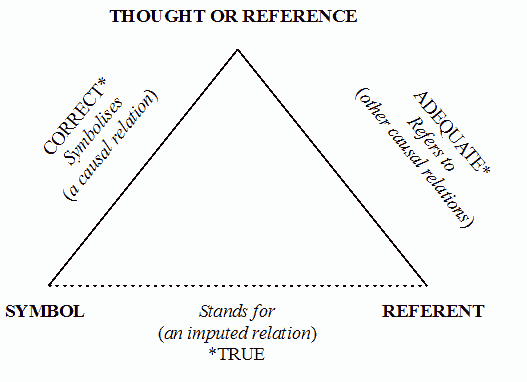標題は,Ogden and Richards による記号論・意味論の古典的名著 The Meaning of Meaning で広く知られるようになった,以下の図のことを指す.

この図のもつ最大の意義は,SYMBOL と REFERENT の間には,すなわち語と事物の間には,本質的な関係はなく,間接的な関係しかないことを明示していることである.ここに直接の関係があるかのように誤解されていることこそが,適切な思考と言語の使用にとって諸悪の根源であると,著者は力説する.この主張は,著書のなかで何度となく繰り返される.
SYMBOL, REFERENCE, REFERENT の3者の関係について,やや長い引用となるが,著者に直接説明してもらおう (10--12) .
This may be simply illustrated by a diagram, in which the three factors involved whenever any statement is made, or understood, are placed at the corners of the triangle, the relations which hold between them being represented by the sides. The point just made can be restated by saying that in this respect the base of the triangle is quite different in composition from either of the other sides.
Between a thought and a symbol causal relations hold. When we speak, the symbolism we employ is caused partly by the reference we are making and partly by social and psychological factors---the purpose for which we are making the reference, the proposed effect of our symbols on other persons, and our own attitude. When we hear what is said, the symbols both cause us to perform an act of reference and to assume an attitude which will, according to circumstances, be more or less similar to the act and the attitude of the speaker.
Between the Thought and the Referent there is also a relation; more or less direct (as when we think about or attend to a coloured surface we see), or indirect (as when we 'think of' or 'refer to' Napoleon), in which case there may be a very long chain of sign-situations intervening between the act and its referent: word---historian---contemporary record---eye-witness---referent (Napoleon).
Between the symbol and the referent there is no relevant relation other than the indirect one, which consists in its being used by someone to stand for a referent. Symbol and Referent, that is to say, are not connected directly (and when, for grammatical reasons, we imply such a relation, it will merely be an imputed, as opposed to a real, relation) but only indirectly round the two sides of the triangle.
It may appear unnecessary to insist that there is no direct connection between say 'dog,' the word, and certain common objects in our streets, and that the only connection which holds is that which consists in our using the word when we refer to the animal. We shall find, however, that the kind of simplification typified by this once universal theory of direct meaning relations between words and things is the source of almost all the difficulties which thought encounters.
Ogden and Richards がこの本を著した目的,そしてこの semiotic triangle を提示するに至った理由は,世の中の言説にはびこっている記号と意味に関する誤解を正すという点にあった.SYMBOL, REFERENCE, REFERENT の3者の間にある関係が世の中に正しく理解されていないという思い,それによって数々の言葉のミスコミュニケーションが生じているということへの焦燥感が,著者を突き動かしていた.その意味では,The Meaning of Meaning は,実践的治療を目的とした書,前置きで Umberto Eco も評している通り,"therapeutic" な書であると言える ("The Meaning of Meaning is pervaded by an abundant missionary fervor. I will call this attitude, with a certain severity, the 'therapeutic fallacy'." (vii)) .著者らが後に Basic English の創作を思いついたのも,このような "therapeutic" な意図をもっていたからにほかならない(Basic English については,「#960. Basic English」 ([2011-12-13-1]) 及び「#1705. Basic English で書かれたお話し」 ([2013-12-27-1]) を参照).
今となっては,semiotic triangle は記号と意味の理論として基本的な部類に属するが,この理論が力説されるに至った経緯には,Ogden and Richards の言語使用に関わる実際的な問題意識があったのである.
・ Ogden, C. K. and I. A. Richards. The Meaning of Meaning. 1923. San Diego, New York, and London: Harcourt Brace Jovanovich, 1989.
・ Eco, Umberto. "The Meaning of The Meaning of Meaning." Trans. William Weaver. Introduction. The Meaning of Meaning. C. K. Ogden and I. A. Richards. San Diego, New York, and London: Harcourt Brace Jovanovich, 1989. v--xi.